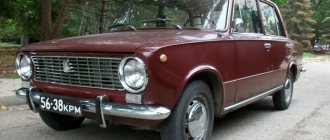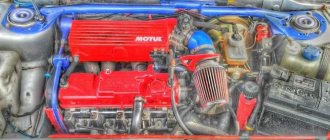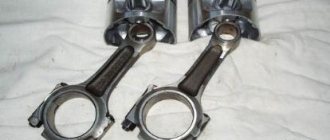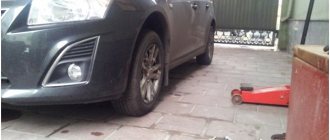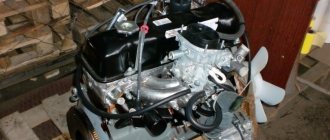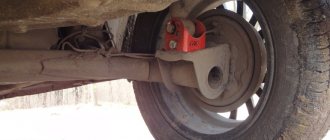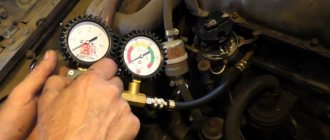Introduction
Almost everyone who has driven a Chevrolet Niva at least once in their life admires this vehicle. However, like all other machines, this unit is not without significant drawbacks. Moreover, its main disadvantage lies in the too weak technical indicators of the engine. A large car with an impressive weight, which is characterized as an all-terrain vehicle, has an output of 80 hp. pp., which, as practice shows, is not enough. Tuning the Chevrolet Niva engine can correct this misunderstanding and increase the performance of the power unit, as well as improve its technical properties. Service center specialists, who have been optimizing the capabilities of cars from various manufacturers for several years, note the opportunity to tune the Niva in several accessible ways. The Chevrolet Niva engine can be upgraded using one or three different methods, and using all methods together allows you to achieve maximum effect.
Methods to increase the output of a Chevrolet Niva engine
Tuning the Chevrolet Niva engine can be done using one of the methods described below. The car owner can optimize the car by:
- replacing standard engine components with more modern tuning elements (changing the geometry of the components);
- turbocharging installations;
- reflashing the electronic control unit (engine chip tuning, which is gaining popularity among all car owners).
In fact, tuning a Chevrolet Niva engine with your own hands is not so difficult, however, along with technical knowledge, the vehicle owner will need considerable financial investments, since without them it will not be possible to optimize the engine, making it as “alive” and dynamic as possible.
Replacing power unit components
Refinement of the Chevrolet Niva engine can begin with the replacement of some components. If a car enthusiast decides to resort to this particular method of modernization, then he will have to pay attention to the cylinder-piston group (CPG) and the crank mechanism (CPM). In addition to all of the above, it will be necessary to bore the sleeves. Thanks to such manipulations, you can try to maximize the working volume and recoil properties.
The motor should be upgraded by means of boring, which helps to significantly expand the internal diameter of the liners. The next step should be a selection of pistons and special ring-shaped elements that will have a certain size. The power unit is then equipped with a crankshaft with enlarged shoulders and smaller connecting rods. The above procedure helps to increase the piston stroke and maximize the volume of the unit, which changes the standard 1.7 to 1.9 liters.
If the tuning of a Chevy engine includes a crankshaft and a cylinder head, then the owner will urgently need to carry out manipulations to increase the volume of the working mixture going to the cylinders, as well as improve their ventilation. Optimization of the engine should also be carried out by modernizing the cylinder head (cylinder head). You will have to bore the intake and exhaust ports, replace the valve (it is necessary to install a standard element of a larger diameter), bore or change all the valve seats.
Complete modification of a Chevrolet engine with your own hands should include a procedure for replacing the exhaust system of the unit. The fact is that by trying to maximize the size of all exhaust pipes, it will be possible in addition to changing the factory catalytic converter, instead of which a flame arrester will be installed.
Tuning the Niva engine, which involves an important structural restructuring of the entire unit, entails the need to change the fuel supply system. While maintaining the factory configurations, even significantly increasing the volume, the motorist will not be able to notice the changes that have occurred due to the fact that the fuel that will enter the cylinders will not be enough. In other words, constructive reconfiguration of the system requires mandatory chip tuning.
As a rule, the changed geometry of the power unit is directly related to its performance, due to which the motor will have 15% greater output than before the optimization procedure. True, the modernized engine will begin to “demand” more power from the owner (the amount of fuel consumed will increase).
Installation of turbocharging on a Chevy Niva car
The second method by which the Chevrolet Niva engine will be modified is the installation of turbocharging. This method is considered one of the most effective, as it allows you to increase productivity and at the same time “raise” torque levels.
With the help of turbocharging, you can achieve a high level of filling the cylinders of the power unit with air due to the fact that forced injection will be present. If a motorist decides to modify the engine in this way, he will definitely have to buy a high-quality turbine, otherwise the positive effect will not be as good as it should be.
On auto forums you can find reviews from Chevy Niva owners who, thanks to tuning, increased engine output by 30%. It is worth noting that installing turbocharging helps not only increase power, but also reduce the amount of fuel consumed. This is due to the fact that maximized output is ensured by better combustion of the fuel mixture and ventilation of the engine cylinders.
Reprogramming the electronic control unit
Chevy engine chip tuning can be considered the most popular method of vehicle modernization. Despite the fact that upgrading in this way does not require too much cost and is considered a relatively budget option for optimizing the capabilities of the engine, the method can be considered quite effective. It is worth considering that do-it-yourself chip tuning does not affect the technical part of the power unit, subjecting it to design alterations.
Chip tuning of a Chevrolet Niva involves making adjustments to the software of the standard ECU, adjusting the fuel supply complex.
Tuning a Chevrolet engine through chipping is good because the motorist can reprogram the ECU at his own discretion. For example, by changing the software, you can reduce fuel consumption, which will occur due to a change in the dynamic and power properties of the engine. As a counterbalance to this, the performance of the power unit can be increased, which, naturally, will increase the volume of fuel required. In addition to all of the above, you can install software that will optimally modernize the operating properties of the engine and maintain gasoline consumption at an acceptable level.
Refinement of the gas distribution mechanism
After replacing the jets and accelerator pump, you can proceed to the second stage of tuning the VAZ-2121 engine. It includes modification of the gas distribution mechanism (GRM), namely, an increase in the diameter of the valves with their subsequent sealing. Such tuning of the Niva 2121 engine will increase the power of the power plant by almost ten percent.
It makes sense to replace the pusher (with a new one with a diameter of at least 1 mm) during the modification of the Niva engine. Work is being done to increase the pusher wells of the intake and exhaust channels. The result of such modification will be especially good for the Niva 4x4.
Subsequent work concerns the replacement of injectors and the control unit itself. Tuning the VAZ-2121 engine will be incomplete unless the standard crankshaft is replaced with an advanced modification, which will significantly increase the power of the power plant. This is due to the increase in piston stroke. It is also recommended to replace the piston rings with new ones. When replacing the crankshaft, boring should be done, as this will provide an additional opportunity to make the engine more powerful. However, be prepared for the fact that fuel consumption will also increase.
Such tuning repairs are capable of:
- increase smoothness;
- reduce wear of parts;
- increase power.
Chevrolet Niva L-Tank2016 › Logbook › Shnivy engine tuning, OKB Engine. Part 1.
“Horsepower sells cars, torque wins races.” — Enzo Anselmo Ferrari is an Italian designer and racing driver, founder of the automobile industry. There is a version that this phrase belongs to Henry Ford, but I don’t care. This phrase fully reflects what is happening now in the auto industry, people are sold cars with powerful engines, although this may not be reflected in the dynamics of acceleration and its traction characteristics from idle to the maximum speed that you use. Can a 1.6-liter engine with a power of 120-130 hp be considered “comfortable”? if this power is delivered at 7000 rpm in civilian use around the city? I'm sure not. When applying it to my car in the city, I use a range from 1000 to 3000 rpm, when driving on the highway the main speed is from 2500 to 4500 rpm, very rarely I turn it higher and only because I need to overtake some car, otherwise some heavy truck will smear you on the asphalt. The maximum engine power primarily determines the maximum speed of the car. And torque is how quickly the motor reaches this maximum power. So, look at the manual for the Chevrolet Niva engine parameters: engine power 80 hp at 5000 rpm, torque 127.4 N*m at 4000 rpm. It turns out that 80 hp. On the Shnivy it gives us a declared maximum speed of 140 km/h, and 127 N*m - 19 seconds to 100 km/h. A torque of 127 N*m for a 1.7-liter engine is an outright disgrace to our automobile industry, and what can you expect from a block and head that has not fundamentally changed since the early 70s of the last century. Soon we will be able to celebrate (think about it) our fiftieth anniversary! of this engine. What do I want from a newly purchased car? Of course, dynamics, faster acceleration to 100 km/h, good traction from idle and up to 4500 - 5000 rpm with a reserve for overtaking. I began to deal with this issue immediately after purchasing the car in November 2021 and looked and talked with all the available camshaft manufacturers at that time. Reviews about companies producing camshafts are very contradictory. I also talked and corresponded with Anatoly Pavlovich Rozhkov, chief designer and owner of the OKB Dvigatel company, he used to work at the Dynamics Design Bureau, an old man, but is in perfect health and continues his work to this day, not every young person can follow him keep up. He also gave me Igor’s contacts; he is known on the drive by his underground pseudonym mehanis. Together they design and develop the intake and exhaust for each shaft, mainly for cars of our domestic automobile industry, but there is work on foreign engines. In a long correspondence with Igor, I realized that I would order everything in a complex: a camshaft for hydraulic compensators 21214-1006010-04+4 (6800 rubles), ECU firmware (5000 rubles) for this shaft - which Igor wrote himself and has already tested on many Shnivas from the European part of Russia there are real reviews about this, and the receiver is the intake manifold (7000 rubles). Frankly, even at the beginning of summer, on vacation, I wanted to go to Ufa on my own and install everything there, but I calculated the costs and realized that traveling 2000 km one way is expensive! As a result, looking ahead, I found a very competent person in Novosibirsk and will do mechanical work here. For the experiment to be a success, ideally it was necessary to find a dyno stand and, step by step, install the tuning components on the car, take measurements and measure torque and power each time, install the ECU - measure, install the camshaft - measure, install the receiver - measure. But to my shame, I never found a dyno in such a big city as Novosibirsk. There is a stand at the Engineering Institute of NSAU, but it only measures up to 3000 rpm, with the engine removed from the car, TsARZ - 15 in Akademgorodok is the same parsley, someone said that there is a wheel stand at the Railway Institute, but I never found any contacts. I will take measurements using the program on my smartphone Speed Logic Lite, the best free one I found on the Play Market. We will measure the dynamics of acceleration in seconds from 0 to 80 km/h, from 0 to 100 km/h and the time it takes to pass a quarter of 402 meters.
First step: engine configuration
First of all, you will have to replace the components of the cylinder-piston group, as well as the crank and connecting rod mechanism, and bore the liners. Thanks to such manipulations, you will increase the volume to a maximum of 2 liters, and therefore the power indicators.
If you decide on this method, first of all, do boring, which will significantly increase the internal space of the sleeves. Only after this are pistons and rings selected to fully match the new diameter.
Then a crankshaft with special elongated arms and, conversely, shortened connecting rods are installed in the engine.
Thus, the piston stroke will increase, which will lead to an increase in volume. But this is not enough. By increasing the volume, you will increase the need not only for more gasoline to be supplied to the cylinders, but also to improve the ventilation system of this unit. Therefore, the cylinder head will also have to be modified. Modernization of the cylinder head also begins with boring the exhaust and intake ports. Afterwards, the valves are replaced with larger elements, for which the valve seats will also have to be bored and replaced.
After such radical changes, experts recommend improving the exhaust system by expanding the exhaust pipes. It wouldn't hurt to additionally replace the catalyst with a flame arrester. The latter will come in handy if you radically increase the car’s power in all respects.
All this will entail the need to reconfigure the power system, because with the standard configuration of the supplied gasoline, the modified systems will not have enough. So, in any case, you can’t do without chip tuning, which means that the modification becomes complex, as mentioned at the beginning of the article.
The above manipulations allow you to increase engine power by 15%, but once again we draw your attention to the fact that fuel consumption will also increase significantly.
Second step: turbocharging
The next point of modification of the power plant is the installation of turbocharging. Even as a stand-alone procedure rather than a comprehensive procedure, this method can significantly increase power and torque.
With the help of this element, the engine cylinders are better filled with air, according to the forced principle.
But you should choose a turbine very carefully. Otherwise, the expected effect will be very different from the one obtained.
A correctly selected and installed turbocharger allows you to increase engine power by 30%, without having a negative impact on fuel consumption. In combination with the previous method, the percentage of improvement increases.
Niva with turbine
The most common way to add power to an engine is to install a turbine or compressor, which will significantly increase the volume of air entering the power plant.
Installing a turbine is not a complex tuning solution, since the turbine itself has a fairly simple structure. The supercharger and turbine impellers are mounted on the same shaft, and the exhaust gases are the drive. Thus, we can observe the most efficient use of energy from combustion products in a car. The absence of interaction between the crankshaft and the turbine shaft also increases the efficiency of the power plant.
In general, the Niva engine can and should be modified, and then your car will become more powerful and last much longer. This is what we should strive for!
Read news about the new Niva
- The modernized Lada Niva Legend (4x4) 2021 was shown on the Internet
- Lada 4×4 Bronto - sales stopped, new details » Lada.Online - all the most interesting and useful about LADA cars
- Description of the instrument panel Lada 4×4 (VAZ 2121, 2131) » Lada.Online - all the most interesting and useful about LADA cars
- LADA Niva – Operating manual – Official LADA website
- Chevrolet Niva gasoline consumption per 100 km
- Buy LADA (VAZ) 2131 (4×4) 2021 in Rostov-on-Don, low price for Lada 2131 (4×4) 2021 on the Avto.ru website
- Fuses Niva 21214 injector «
- The new large Lada 4×4 Niva “Bigster” 2021-2022 based on the Dacia Bigster was shown for the first time. The SUV has changed beyond recognition
Also interesting: Do-it-yourself trunk for the field
Third step: flashing the ECU
The most inexpensive way to increase the power of an off-road SUV, because chip tuning is a software modification and does not involve technical intervention.
Replacing and adjusting ECU software is the essence of flashing. In this way, it is possible to change the operation of the electronic control unit, adjust the fuel supply and reduce its consumption, due to the engine’s performance in terms of power and dynamics. You can increase engine power by about 15% just by chipping.
Doing the work yourself
The low wear resistance and efficiency of an SUV engine of Russian origin determines that it is practically impossible to do without mechanical modifications. Many people call such work a change in geometry.
The internal combustion engine installed on the vehicle in question can have many systems modified. Experts recommend starting with upgrading the carburetor. This is due to the fact that due to the use of imperfect production technology, its efficiency is very low. Modernization is carried out as follows:
- To begin with, it is recommended to replace the nozzle. The factory version is installed with 1 cam, but should be installed with 2 cam.
- The pump accelerator should be updated.
- All sharp corners that could cause turbulence in the air flow are removed.
- Some craftsmen also clean accessible surfaces, reducing their roughness. Due to this, the efficiency indicator is significantly reduced.
Insert: Important: It is important to clean the carburetor structure from carbon deposits and dirt. To do this, use gasoline or a rag. If the dirt has become too deeply embedded in the surface, you can use special cleaning products.
Experts do not recommend chipping a naturally aspirated engine. You can further increase engine power if you try to increase the piston stroke. This can be achieved by installing another crankshaft with a stroke of 84 mm, suitable for the VAZ 2130
. The piston has a diameter of 82 mm, but the piston pin must be offset by 2 mm. After this, the working volume will become 1.8 liters.
In the future, if you bore the block to 84 mm. with the same crankshaft, the volume will become 1.9 liters. But that’s not all, in the future you can increase the filling capacity of the working cylinders. This is achieved by boring and installing valves with an increased diameter of their plates. This operation is quite complex and requires special equipment. It is also advisable to use lightweight connecting rods and then you can have about 100 horses at the output.
Lubricant supplied through the oil pump extends engine life. To improve the performance of the oil pump when tuning the Niva engine, you need to take another pump and cut off part of the housing with the parting plane from it. The thickness of this “pancake” should be about 11 cm. Using milling, cut off the excess and leave a thickness of 10 mm.
Next, do the following to remove chamfers on the edges of the teeth:
- We compress, that is, remove, the drive gears.
- We trim one of the gears by 0.75 mm on each side.
- We cut the second gear to 11.5 mm (after trimming).
- We repeat the operation with the remaining gears (driven).
This car is distinguished by its simplicity of design, easy accessibility to all components and mechanisms, as well as its increased reliability.
Replacing Chevy Niva engine components
So, the first method is engine tuning, which involves replacing some components. First of all, this concerns the cylinder-piston group (CPG) and the crank mechanism (CPM), which requires boring of the liners. All this allows you to increase the working volume and, as a result, the power indicator.
First of all, boring is carried out, allowing the inner diameter of the liners to be increased. After this, a selection of pistons and piston rings of appropriate size is made. In addition, the engine is equipped with a crankshaft with elongated arms, as well as shortened connecting rods. Thanks to this, it is possible to increase the piston stroke. All this leads to an increase in volume from 1.7 liters, which the factory Chevy engine has, to 1.9 liters.
But replacing only the crankshaft and CPG motor is not enough. An increase in volume entails the need to increase the combustible mixture supplied to the cylinders and to better ventilate them. For this purpose, the cylinder head (cylinder head) is also subjected to tuning. First of all, the intake and exhaust windows are bored, and the valves are replaced with larger ones. At the same time, the valve seats are bored out and replaced.
Boring of inlet and outlet windows
Additionally, you can completely change the exhaust system by increasing the diameter of the exhaust pipes, and also replace the catalytic converter (catalyst) with a flame arrester.
Note that design changes to the engine will entail the need to reconfigure the operation of the fuel supply system, since with standard configurations and an increased volume, there will not be enough fuel supplied to the cylinders. That is, it will still be necessary to carry out chip tuning.
All this tuning, associated with changes in geometry, allows you to increase engine power by 15% of the nominal. But it is worth noting that an increase in volume will also entail an increase in fuel consumption.
Exhaust system tuning
Modifying the exhaust system with the right approach will help increase engine power. Installing advanced, sporty versions of the intake and exhaust manifolds (the latter are also called spiders) will optimize the process of air supply and exhaust gas removal. Thanks to this, the efficiency and partly the power of the power unit increases.
This effect can be enhanced by installing a muffler resonator. It streamlines the removal of exhaust gases and gives the engine a melodious sound, thanks to its design features.
Separately, we can highlight the installation of a snorkel on the VAZ 21214 (21213). This is a pipe that allows you to avoid water hammer when the car passes water obstacles. The consequence of this is deformation of the connecting rods and damage to the block structure. Water enters the power unit through the air intake system, so the optimal solution for a Niva car would be to vent it onto the roof. This must be done if the car is preparing to participate in competitions or drive in extreme off-road conditions.
Installation of turbocharging on a Chevrolet Niva
The second method of tuning the Niva Chevrolet power plant is to install a turbocharger. Moreover, this method allows you to significantly increase power and also increases torque.
Turbocharging provides significantly better filling of the engine cylinders with air due to forced injection.
With this tuning option, you should carefully select a turbine, otherwise the positive effect of its use may be significantly lower than expected.
Tuning in this way allows you to achieve an increase in engine power by 30%. At the same time, turbocharging only has a positive effect on fuel consumption, since it is reduced. And the increase in power is achieved due to better fuel combustion and ventilation of the engine cylinders.
Tuning options
When refining a Niva engine, a new crankshaft, cylinders and piston system are most often installed.
As a result, the car receives excellent speed characteristics and cross-country ability. There are two types of Niva engine tuning. The first includes chip tuning, and the second includes mechanical modification of the element. Chip tuning includes software upgrades, and is carried out only on new, fuel-injected SUVs. It includes flashing the control unit settings. It is performed by specialists quite quickly - within half an hour, but requires knowledge of software and additional electronic equipment.
Mechanical modifications are possible on any Niva, and this is the most popular type of tuning of a car’s power plant. With its help, you can significantly improve the technical characteristics of vehicles, and it is based on making some changes to the vehicle systems.
